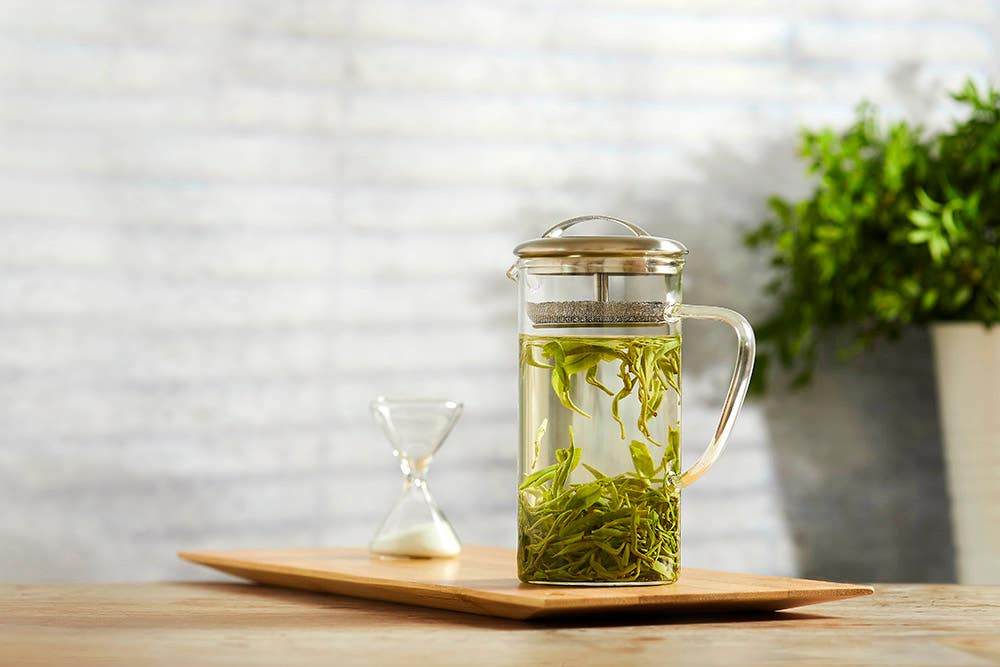A Deep Dive Into Our Baojing Gold Spring Tea
Baojing Gold, Spring 2020, produced on March 19 by Mr Long in Ludong Mountain Garden
In this piece, we introduce one of our new spring green teas for 2020 and describe who we think will enjoy it. We will also talk about what makes it special, who made it and why we selected it, as well as the best ways to find flavour, balance and enjoyment at home from this fresh spring tea.
Every year as winter turns to spring, the first green teas are hugely anticipated by tea lovers in China. We select one or two of the best that we can find and very often these come from looking outside the well-known areas.
Baojing Gold is a tea with a long heritage. It is locally known as a tea that has been gifted to the emperor since the 16th century and is thought to have derived from just one mother tree in Golden Village, Hunan, China.
It has a refreshing, pure green fragrance with a soft milky character.

Origin: Ludong Mountain Garden, Hunan, China.
Cultivar: Camellia sinensis var. sinensis “Baojing Huang Jin Cha”
Name: Named after the place of origin, Baojing County in Hunan Province, and the gold leafed cultivar from which it is traditionally made.
Style: Hand-dried spring green tea
Terroir: Western Hunan (Xiangxi Autonomous Prefecture)
Altitude: Picked at 500m above sea level.
Picking Season: Spring
Leaf: Twisted sets of silver-grey buds and green leaves
Oxidation: 0%
Production: Organic agriculture
Infusion: A light green milky infusion.


What kind of teas does Western Hunan produce?
Usually they are lightly rolled, fluffy, hand-dried, high quality green teas made from the picking of one leaf and one bud. They taste light and delicate and the best are highly fragrant with a milky quality.

The climate is subtropical and tea is grown in hilly terrain, meaning winter temperatures are cold and the tea bushes are dormant. In spring, they sprout new growth and from these buds and leaves, the early green teas are made. They are packed full of nutrients and flavour that the bushes have been collecting over winter.
There are several cultivars local to the area. The Baojing cultivar is famous for its gold or yellow leaves that are rich in amino acids, contributing to the umami flavour.

How did we find this batch of tea and who made it?
We have found excellent spring teas from Western Hunan before, so we are always on the lookout for teas from here.
If you have seen our article on sourcing spring teas in lockdown, you’ll know that Tom (our tea buyer) has not been able to visit anywhere this year. However he visited Western Hunan last year and knows Mr Long is an excellent producer, so he arranged for some samples to be sent to his home in London earlier this year. When Tom tasted them, they stood out immediately and so he very quickly reserved this standout batch.
This tea is made by Mr Long from his garden near Ludong Mountain which is run without the use of any pesticides.

What is this batch like to drink? Aroma, taste and texture
The simplicity of the picked leaves is captured in the cup. The aromas are pure and fragrant of fresh pasture and wildflowers, while the taste has lots of umami (typical of the cultivar). The texture is rounded and soft and gives and impression of milkiness – it looks milky too, the infusion is an opaque, tinged light green.
When to drink?
Spring teas are best drunk in spring - they are all about those fresh spring flavours after all! The light taste and refreshing quality works well as the weather is warming up but is not yet up to the scorching summer temperatures.
Delicate green teas can be drunk at any time during the day, but we really like to drink this tea in the early afternoon as it’s so refreshing. This tea will not work with food as you’ll lose a lot of the character and nuance with the flavours of the food dominating.
What is it like to make and how easy is it to get a good taste?
For a 250ml serve, make it in a teapot of the same size and pour the full infusion into your cup.
When we were testing the best ways to make Baojing Gold, we knew we wanted to bring out the characteristic umami notes as much as possible. In the same way as we made Gyokuro (another tea that has loads of umami), we experimented with cooler water and it gave great results. (When we talk about umami, if you’re not sure what we mean, look for savouriness – and think about the depth of the flavour and how the tea feels in your mouth. Teas with lots of umami, like this one, will feel rounded and soft).
This worked well 4g/ 250ml; 70 degrees; 3 minutes per infusion (minimum 2 infusions).

Tall Glass Infusion Method:
We really recommend giving this method a go, as long as you don’t mind getting a few tea leaves in your mouth! It is the way that most spring green teas will be traditionally enjoyed in their home areas in China. All you need is a tall glass.
Use slightly hotter water than the 250ml method. Immediately you will notice that the fragrance or floral aromas are enhanced as they get captured at the top of the glass and are strong for the first few sips. The closer you get to the leaves, the more intense the flavours will be with the umami intensity really strong by the time you reach the last ¼ of the glass. We recommend topping up the glass when there is around 1/3 - ¼ left. You can use the leaves for almost a full morning or afternoon’s drinking – we really like the difference you’ll get from the top to the bottom of the glass as the infusions go on and on.
Try this: 4g/ 250ml; 90 degrees; 5 minutes.
For all of these infusion methods, you’ll get the best results with soft, filtered water (which we highly recommend).
Who is this tea for?
If you want to explore one of the most revered and special tea categories from China, Baojing Gold will show you the spring-fresh character of these teas. You’ll want a little time to savour the tea, given its lightness and nuance.
If you like Gyokuro or know that you like umami flavours, or if you like Shimen Green Mountain with its reminiscent spring character, it is very likely you will also enjoy Baojing Gold.


